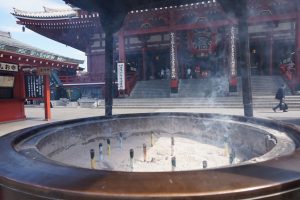Made of grains of resins and other materials that burn with a fragrant odour, even nowadays incense is widely used as an oblation and in religious ceremonies.

Image source:
https://search.creativecommons.org/photos/aed7cacb-34ae-4e85-b92a-d064478c7ca7 by simonallardice
Composition and Burning Methods
Different cultures manufactured incense in a variety of materials, depending on locally available ingredients. Incense must be distinguished in two burning methods: indirect-burning, which does not contain combustible material, therefore it requires a separate heat source; direct-burning incense, lit directly by a flame which burns the rest of the incense without additional applications. The base sustains the burning of the material, and it can be done in charcoal or wood powder, combined with fragrant materials, or alternatively in botanical material or resins (such as Gum Arabic) mixed with natural fragrances.

Image source:
https://commons.wikimedia.org/wiki/File:IncenseWikiVers.jpg Author: Sjschen
Sacred and Profane Usage
Thanks to its versatility, incense has been used on different occasions, both sacred and profane. The fragrance can be of such great strength that obscures other less desirable odors and this explains the usage of incense in funerary ceremonies. Anyway, people who appreciate the fragrance use this material for aesthetic reasons. Incense made from citronella can repel mosquitoes and other insects. This modern usage was actually discovered a long time ago by Zen Buddhists, in order to avoid the distraction during their meditative practices due to bothersome insects. Moreover, the regular burning of incense has been used sometimes for chronological measurement. Many people burn incense to appreciate its smell, without assigning any other specific significance to it. An example is the traditional Japanese art of appreciating incense, known as Kōdō, following established practices on how to prepare and enjoy this fragrance.

Image source:
https://search.creativecommons.org/photos/e7c928fe-488d-48f5-97df-3a4700987d19 by acameronhuff
Religious use of incense is prevalent in many cultures, from East to West, and may have roots in practical and aesthetic uses. One common, ancient motif is the usage as a form of oblation or ceremonial offer to a deity. Such use was common in Judaic religion and remains in use in the Catholic, Orthodox, and Anglican churches, and also in Taoist and Buddhist cults. Sometimes it has been used as an aphrodisiac in some cultures: ancient Greek and Egyptians linked incense with sexual desires. Another worth mentioning use is related to alternative and folk medicines. Someone believes that incense is capable of cleansing and restoring energy in healing crystals, also eliminating negative energy.
Since the Dawn of Times
In ancient history, incense has been widely traded. Incense-bearing trees were imported from other African regions and the Middle East into ancient Egypt, where incense was prominent in religious and mortuary rites. The Babylonians used it while divining oracles, or as an offer for deities. Israelites were assigned to its miraculous powers, setting altars with incense. We do know that Hindus were in the habit of using incense for domestic and public rituals, and so do Buddhists, who burn it also at festivals and initiations. In China, incense was burned to honor ancestors and household gods, and in Japan, it was incorporated into the Shintō ritual.

Image source:
https://en.wikipedia.org/wiki/Incense#/media/File:Egyptian_-_Egyptian_Incense_Burner_-_Walters_54498_-_Side.jpg
Ancient Greeks used to burn woods and resins as an oblation and for protection against evil, but the use of incense was not that common. In Rome, imported incense became important, especially in sacrifices and in the public cult of the emperor. Lastly, even the early Christian church began to use incense around the 4th century AD during the eucharistic ceremonial, and its usage has come to this day.
Info source:
https://en.wikipedia.org/wiki/Incense#Composition
https://www.britannica.com/topic/religion
https://www.heddels.com/2018/12/incense-101-history-products/
https://www.sacredgemstone.com/pages/cleansing-crystals-stones
